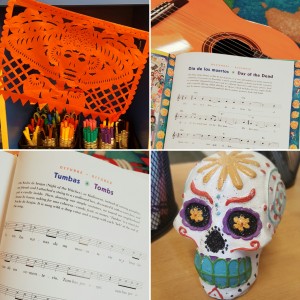Two years ago, I was preparing to celebrate a holiday in my class for the very first time. This was a celebration that I knew nothing about. I was clueless. But more importantly, I was hesitant. Little did I know, I was on the verge of an exciting new adventure. This is the story of how I fell in love with Día De Los Muertos.
 It was early October and the autumn breeze was finally starting to blow after a very hot summer. During a World Languages team meeting, we were discussing the Despicable Me Minion costumes that we would wear for the school Halloween parade and I asked if there were any classroom celebrations that happened during this time. My colleague, Carrie Peralta, began to enthusiastically share the activities and class décor she enjoyed for Día De Los Muertos.
It was early October and the autumn breeze was finally starting to blow after a very hot summer. During a World Languages team meeting, we were discussing the Despicable Me Minion costumes that we would wear for the school Halloween parade and I asked if there were any classroom celebrations that happened during this time. My colleague, Carrie Peralta, began to enthusiastically share the activities and class décor she enjoyed for Día De Los Muertos.
Wait, pause…. “Is that that holiday where people paint their faces like skulls?”
Yes! That was exactly the holiday that Carrie was talking about. This holiday, while celebrated throughout Latin America and the United States, is particularly associated with Mexico and honors the dead through celebration. One of the central characteristics of the holiday is the beautiful altar that families create in their homes to honor family members that have passed away. These altars include food and other items that their loved ones would have enjoyed while alive. During this most celebratory night, loved ones return, partake of some of the food from the altar, and party with their family.
Whew….deep breath!
This all seemed very strange to me. The skulls. The altar. The dead. All of it! But I was curious so instead of walking away from the whole idea, I researched, decorated my room, and designed activities geared toward young students. I learned that this was not a scary or strange thing to fear. This was a celebration of life, values, and culture. Before long, I found myself decorating quite the elaborate ofrenda (altar) and singing about esqueletos (skeletons) and tumbas (tombs) with the children. The students were joyous, engaged, and eager to share stories of loved ones they would celebrate on this day.
Aha! There is so much more to Latino culture than I thought!
Although I am of Latin American heritage, I had never been exposed to this holiday. My first Día De Los Muertos was a time of discovery that connected me with the beliefs, values, art, food, language, stories, and history of a people that were not my own. That expanded my worldview and made me see beauty where I had not seen it before. Two years after that first celebration, you might find me meditating with a Día De Los Muertos coloring book, cutting out cardboard sugar skulls for class crafts, or browsing holiday décor at the local craft store. I appreciate something new and that has added to my life.
“Appreciation is a wonderful thing. It makes what is excellent in others belong to us as well.” ~Voltaire
Learner, Thinker, Writer: Lilliangina Quiñones serves the Trinity School community as a World Languages Teacher & Co-Chair of the Faculty Diversity Committee.
Thank you Gina for sharing about Dia De Los Muertas. It is my favorite celebration! I love the “ofrendas” (altars) and the symbolism behind all of the imagrey. It is a powerful cultural celebration of life and honoring our ancestors! Thanks for sharing!
Thanks for reading Pat! Yes, truly it is a beautiful tradition. I loved learning about the indigenous origins of the holiday. It is a holiday that withstands the test of time and shows the resilience of Latin American people.
Leaning into curiosity instead of shutting down due to ignorance. How much more we could learn if we followed suit. Thanks for this poignant post.
Thank you Maryellen. This practice of leaning into curiosity, asking questions, and making connections is so powerful. It has stretched me intellectually but more importantly helped me grow in my ability to show compassion and empathy. It is a practice in progress but I hope I can continue to inspire and be inspired by others who are doing the same.
Thank you for sharing, Gina! It’s amazing how traditions can seem “strange” at first, and I appreciate you choosing to reach instead of walking away. Your post makes me wonder what traditions I have written off (or walked away from) when I should have reached towards it for the benefit of my students and my own understanding of self.
Thanks for your comment, Julia. May we continue to encourage each other to reach and grow in the process.
What a lovely post, Gina! I like how you touched on making this holiday accessible to our younger students. I think it’s important for us to embrace these cultural celebrations and consider deep down the actual values they help to manifest in our children. Ultimately, it is just like you said – we need a spirit of openness so that we can see the “beauty where [we] didn’t see it before”.